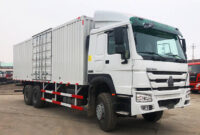Army Surplus Trucks For Sale: Your Ultimate Guide to Owning a Piece of Military Might pickup.truckstrend.com
In a world increasingly dominated by sleek, mass-produced vehicles, there’s a unique and enduring appeal to something built with an entirely different purpose in mind: raw utility, unyielding durability, and uncompromising capability. This is the realm of Army Surplus Trucks For Sale. These aren’t just vehicles; they are testament to engineering designed for the most demanding environments on Earth, now repurposed for civilian life. Whether you’re an off-road enthusiast, a prepper, a homesteader needing serious hauling power, or simply someone who appreciates a vehicle built to last, exploring the market for army surplus trucks can open up a world of rugged possibilities.
This comprehensive guide will navigate you through everything you need to know about acquiring, understanding, and maintaining these fascinating machines. From their origins to the intricacies of ownership, we’ll equip you with the knowledge to make an informed decision and potentially drive home a true piece of history.
Army Surplus Trucks For Sale: Your Ultimate Guide to Owning a Piece of Military Might
What Exactly Are Army Surplus Trucks?
Army surplus trucks are former military vehicles, decommissioned by the armed forces and made available to the civilian market. These vehicles, ranging from light utility trucks to heavy-duty cargo haulers, were originally designed and built to stringent military specifications. This means they are inherently more robust, capable, and often simpler in design than their civilian counterparts, prioritizing function over form, and reliability over luxury.
The availability of these trucks stems from various reasons: routine upgrades to newer models, inventory reduction, or the end of a vehicle’s service life. Once deemed surplus, they undergo a demilitarization process, which typically involves removing sensitive military equipment, weapons systems, and sometimes even repainting them from their original camouflage. What remains is a highly functional and durable platform, ready for a new chapter.
The Unbeatable Appeal: Why Buy a Surplus Truck?
The allure of army surplus trucks extends far beyond their imposing presence. Here are compelling reasons why they continue to attract a dedicated following:
- Unrivaled Durability and Reliability: Built for combat zones and extreme conditions, these trucks are over-engineered. Their robust frames, heavy-duty suspensions, and powerful diesel engines are designed to withstand abuse that would cripple a standard civilian vehicle.
- Exceptional Off-Road Capability: Most surplus trucks feature high ground clearance, multi-axle drive systems (4×4, 6×6, 8×8), and robust differentials, making them incredibly capable in challenging terrain – mud, snow, sand, or steep inclines.
- Cost-Effectiveness: While initial purchase prices vary, many surplus trucks offer an incredible amount of capability per dollar compared to new heavy-duty civilian trucks. They represent significant value for those needing serious hauling or off-road prowess without breaking the bank.
- Simplicity and Repairability: Often, military vehicles eschew complex electronics in favor of mechanical reliability. This makes them easier for the mechanically inclined owner to diagnose and repair, reducing reliance on specialized dealerships.
- Parts Availability: Given their widespread deployment and long service lives, parts for many common surplus models are surprisingly abundant, either through military surplus channels or aftermarket suppliers.
- Versatility: These trucks can be adapted for a multitude of uses: expedition vehicles, overland campers, farm workhorses, recovery vehicles, parade vehicles, or simply unique daily drivers (where permissible).
- Unique Ownership Experience: Owning a military surplus truck is more than just owning a vehicle; it’s owning a piece of history, a conversation starter, and a symbol of rugged independence.


Types of Army Surplus Trucks You Might Encounter
The world of army surplus vehicles is diverse, with various models designed for specific roles. Here are some of the most commonly available types:
- M35 Series (Deuce and a Half): Perhaps the most iconic, this 2.5-ton 6×6 cargo truck is known for its legendary durability and straightforward design. Powered by multi-fuel diesel engines, they are a popular choice for enthusiasts and practical users alike.
- M939 Series (Five-Ton): A larger, more powerful evolution of the M35, the M939 series (including M923, M925, M927, M929, M931 variants) are 5-ton 6×6 trucks often equipped with Cummins engines. They offer greater payload capacity and often come with more modern features like power steering.
- HMMWV (Humvee): The High Mobility Multipurpose Wheeled Vehicle is a light, highly mobile 4×4 utility vehicle. While iconic, purchasing and titling these can be more complex due to their "off-road use only" status in many states (unless specifically demilitarized for road use, which is rare for direct surplus).
- CUCV (Commercial Utility Cargo Vehicle): Essentially militarized versions of standard civilian trucks (like Chevrolet K5 Blazers or C/K series pickups from the 1980s), these 4×4 vehicles are more road-friendly and often easier to integrate into civilian life, though less robust than dedicated military designs.
- FMTV (Family of Medium Tactical Vehicles): A more modern series (LMTV – Light Medium Tactical Vehicle, and MTV – Medium Tactical Vehicle), these trucks offer advanced features, better ergonomics, and more powerful engines. They are newer to the surplus market and command higher prices.

Where to Find Your Next Military Workhorse: Sourcing Surplus Trucks
Finding an army surplus truck requires knowing the right channels. Here are the primary avenues:
- Government Auctions (Primary Source):
- GovPlanet: This is the leading online marketplace for military surplus equipment, contracted by the U.S. Department of Defense. They regularly auction off a vast array of vehicles, often with detailed descriptions, photos, and inspection reports. This is often where the best deals can be found, but it requires careful research and understanding of auction terms.
- GSA Auctions: The General Services Administration also auctions surplus federal property, which can sometimes include vehicles.
- Private Dealers and Brokers: Numerous specialized dealers across the country buy from government auctions, perform light reconditioning, and resell these trucks to the public. While often more expensive than direct auction purchases, dealers offer convenience, sometimes provide warranties, and handle paperwork.
- Online Marketplaces and Classifieds: Websites like eBay, Craigslist, and dedicated forums (e.g., Steel Soldiers) often have individuals selling their surplus trucks. These can be good for finding specific models or already-modified vehicles, but "buyer beware" applies even more here.
- Specialized Forums and Communities: Online communities like "Steel Soldiers" are invaluable resources for locating trucks, getting advice, and connecting with other enthusiasts.
Navigating the Purchase Process: A Step-by-Step Guide
Acquiring an army surplus truck is different from buying a used car. Follow these steps for a smoother experience:
- Research Thoroughly: Understand the different models, their pros and cons, common issues, and parts availability. Determine which model best suits your needs and budget.
- Set a Realistic Budget: Beyond the purchase price, factor in transport costs, potential repairs, maintenance, registration, insurance, and possibly upgrades or modifications.
- Inspect (or Have Inspected) the Vehicle: If buying from an auction like GovPlanet, utilize their inspection reports, but always try to inspect in person if possible. For private sales, a pre-purchase inspection by a qualified mechanic familiar with military vehicles is highly recommended. Look for rust, fluid leaks, engine condition, tire wear, and electrical issues.
- Understand the Bidding/Buying Process: For auctions, familiarize yourself with the bidding increments, buyer’s premiums, payment deadlines, and pickup logistics. For dealers, understand their pricing structure and any warranties offered.
- Payment and Documentation: Be prepared for wire transfers or cashier’s checks. Ensure you receive all necessary documentation, especially the SF97 form (Certificate of Release of a Vehicle), which is crucial for titling.
- Transportation: Most military surplus trucks are large and heavy. Unless they are road-legal and you are confident driving them long distances, you will need to arrange for professional transport. Factor this cost into your budget.
- Titling and Registration: This is often the most challenging step. Laws vary by state regarding how to title a military vehicle, especially those that didn’t come with a standard VIN or were initially marked "off-road use only." Be prepared to work with your local DMV, providing the SF97 and potentially undergoing an inspection.
Important Considerations Before You Buy
While exciting, owning a military surplus truck comes with unique considerations:
- Condition and Maintenance: These vehicles are often sold "as-is, where-is" and may require significant mechanical work. Budget for immediate repairs and ongoing maintenance.
- Parts Availability and Cost: While common models have good parts support, some components can be harder to find or more expensive than standard civilian parts.
- Legality and Titling: As mentioned, this is critical. Verify your state’s specific requirements for registering former military vehicles. Some states are easier than others.
- Fuel Type: Many older models run on diesel or are "multi-fuel" (can run on various combustible liquids, though diesel is usually preferred). Understand their fuel requirements and efficiency (which is typically low).
- Size and Storage: These trucks are BIG. Do you have adequate space to store and work on such a large vehicle?
- Driving Experience: Driving a large, heavy military truck is different from a passenger car. They have manual transmissions, air brakes (on many models), slow acceleration, and large turning radii. You’ll need to get accustomed to their unique handling characteristics.
- Emissions and Inspections: Some states have strict emissions regulations that older diesel military vehicles might struggle to meet. Check local inspection requirements.
Restoration, Customization, and Maintenance: Keeping Your Truck Running
Once you’ve acquired your truck, the journey truly begins. Many owners embark on restoration projects, bringing these workhorses back to their former glory or customizing them for specific civilian uses.
- DIY vs. Professional: Due to their mechanical simplicity, many owners enjoy performing their own maintenance and repairs. However, for complex issues or specialized tasks, finding a mechanic familiar with military diesels is crucial.
- Common Maintenance: Regular fluid changes (oil, coolant, gear oil), greasing, air filter replacement, and brake checks are essential.
- Upgrades and Customization: Popular modifications include converting to single rear wheels (SRW) for easier tire replacement, installing power steering (if not already present), adding modern lighting, comfortable seating, and building custom beds or expedition boxes.
- Community Support: The military surplus vehicle community is incredibly supportive. Online forums and local clubs are excellent resources for advice, troubleshooting, and even finding parts.
Challenges and Solutions
While rewarding, ownership can present challenges:
- Challenge: Rust: Many older vehicles have spent decades outdoors.
- Solution: Thorough inspection before purchase. Address surface rust with wire brushing and rust encapsulating primers. For structural rust, professional welding may be required.
- Challenge: Parts Availability for Obscure Models: While common models are well-supported, rarer variants can pose issues.
- Solution: Network with enthusiasts, check specialized military surplus parts dealers, and be open to fabricating parts or adapting civilian alternatives.
- Challenge: Finding Knowledgeable Mechanics: Most auto shops aren’t equipped or experienced with military trucks.
- Solution: Seek out heavy equipment mechanics, truck repair shops, or join online forums to find recommendations from other owners. Learn to do basic maintenance yourself.
- Challenge: Legal and Titling Hurdles: Especially for "off-road use only" Humvees or states with strict regulations.
- Solution: Research your state’s DMV laws before purchasing. Be prepared for a lengthy process, and consider working with a title service specializing in unusual vehicles if needed.
- Challenge: Transport Costs: Moving a non-running or distant truck can be expensive.
- Solution: Factor transport into your initial budget. Consider hiring a specialized heavy haulage company or, if the truck is drivable, planning a scenic road trip home.
Estimated Price Table for Common Army Surplus Trucks For Sale
Prices for army surplus trucks are highly variable, influenced by condition, mileage, specific model variant, auction dynamics, and dealer markups. The table below provides estimated ranges for common models sold through government auctions like GovPlanet, assuming a running but potentially needing-work condition. Dealer prices will typically be 20-50% higher, reflecting reconditioning and convenience.
| Model Series | Typical Condition | Estimated Price Range (USD) | Key Features / Notes |
|---|---|---|---|
| M35A2/A3 | Runs & Drives | $4,000 – $12,000 | "Deuce and a Half" 2.5-ton 6×6. Multi-fuel diesel. Iconic, simple, highly durable. A3 has turbodiesel & auto trans. |
| M923/M925/M927 | Runs & Drives | $6,000 – $18,000 | "Five-Ton" 6×6. Cummins diesel. Higher payload. More modern cabin than M35. |
| CUCV (M1008/M1009) | Runs & Drives | $2,500 – $8,000 | Militarized Chevy K30/K5 Blazer. 6.2L Diesel. Easier to register. More civilian-like comfort. |
| HMMWV (Humvee) | Runs & Drives | $10,000 – $40,000+ | Highly capable 4×4. Often "Off-Road Use Only" title, making road registration difficult in many states. |
| FMTV (LMTV/MTV) | Runs & Drives | $15,000 – $50,000+ | More modern trucks (2.5-ton LMTV, 5-ton MTV). Caterpillar/Cummins engines. Advanced features. Newer to surplus. |
Note: These prices are estimates and can fluctuate significantly based on auction demand, vehicle condition (e.g., rust, engine health), specific configuration (e.g., winch, hardtop), and location. Always check current auction results and dealer listings for up-to-date pricing.
Frequently Asked Questions (FAQ)
Q1: Can I legally drive an army surplus truck on public roads?
A1: Yes, in most states, provided you can successfully title and register it, and it meets local safety and emissions requirements. The biggest hurdle is often the titling process, especially if the vehicle was originally issued with an SF97 "off-road use only" designation (common for Humvees). Research your state’s DMV regulations thoroughly.
Q2: Are parts hard to find for these trucks?
A2: For common models like the M35 and M939 series, parts are surprisingly abundant through specialized military surplus parts dealers and online communities. Newer FMTV parts can be found through military channels or heavy equipment suppliers. Less common models might require more effort.
Q3: What kind of fuel economy can I expect?
A3: Don’t expect efficiency. Older military trucks typically get very poor fuel mileage, often in the range of 4-10 miles per gallon (MPG), depending on the model, load, and terrain. They are built for power and durability, not economy.
Q4: Do I need a special license to drive these?
A4: Most M35 and M939 series trucks, being under 26,001 lbs Gross Vehicle Weight Rating (GVWR), can typically be driven with a standard Class D (car) license, provided they are not used for commercial purposes. Always verify your state’s specific CDL requirements, as laws can vary.
Q5: Are these trucks comfortable for daily driving?
A5: Generally, no. They are utilitarian vehicles designed for rugged environments, not comfort. Expect basic cabins, limited amenities, loud engines, and a firm, bouncy ride. They are best suited for specific tasks or occasional recreational use rather than daily commuting.
Q6: What’s the deal with "multi-fuel" engines?
A6: Older M35s famously had "multi-fuel" engines, meaning they could theoretically run on various fuels like diesel, kerosene, jet fuel, or even gasoline (with oil added). In practice, it’s best to stick to diesel for optimal performance and engine longevity.
Conclusion
The market for Army Surplus Trucks For Sale offers a compelling proposition for those seeking a vehicle that stands apart from the crowd. These are machines forged in the crucible of military necessity, built to endure, and engineered for uncompromising performance in the toughest conditions. While ownership comes with its unique set of challenges – from navigating the titling process to understanding their specific maintenance needs – the rewards are immense.
From the satisfaction of piloting a true piece of history to the unparalleled capability they offer for work or adventure, an army surplus truck isn’t just a purchase; it’s an investment in robust utility and an engaging hobby. For the right individual, one of these military workhorses can truly be the ultimate vehicle, ready to tackle whatever civilian life throws its way, with power, durability, and an undeniable sense of purpose.



